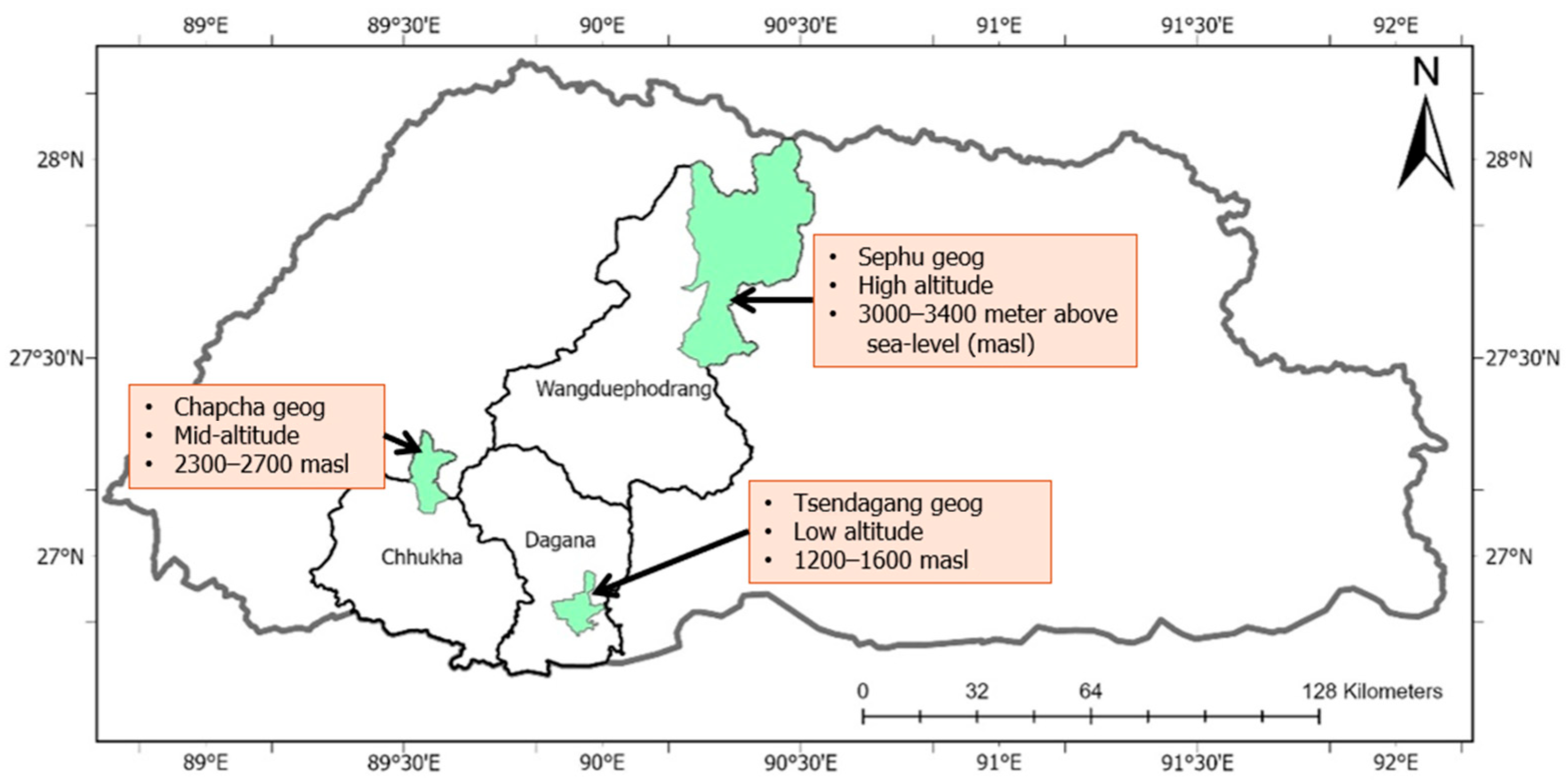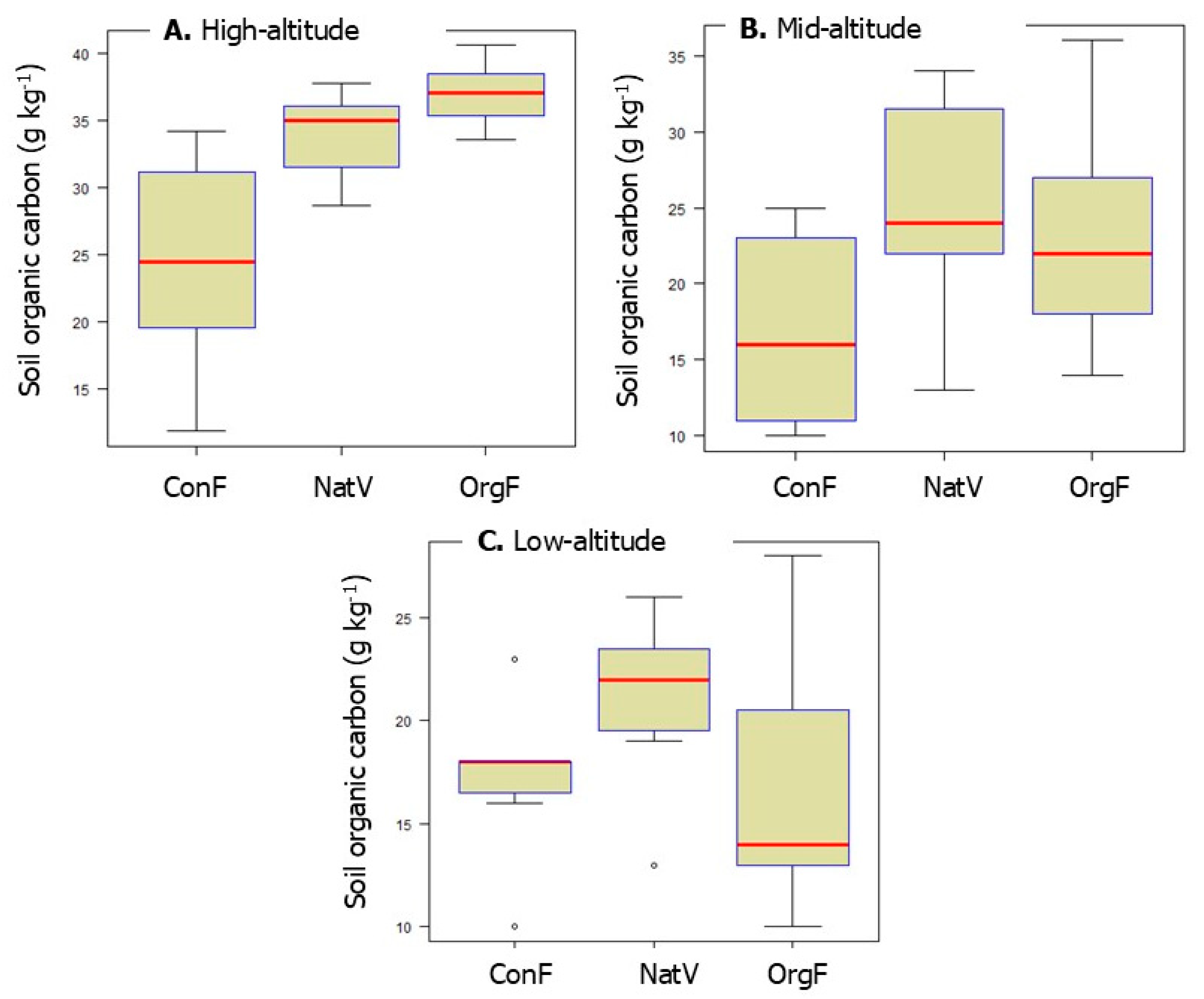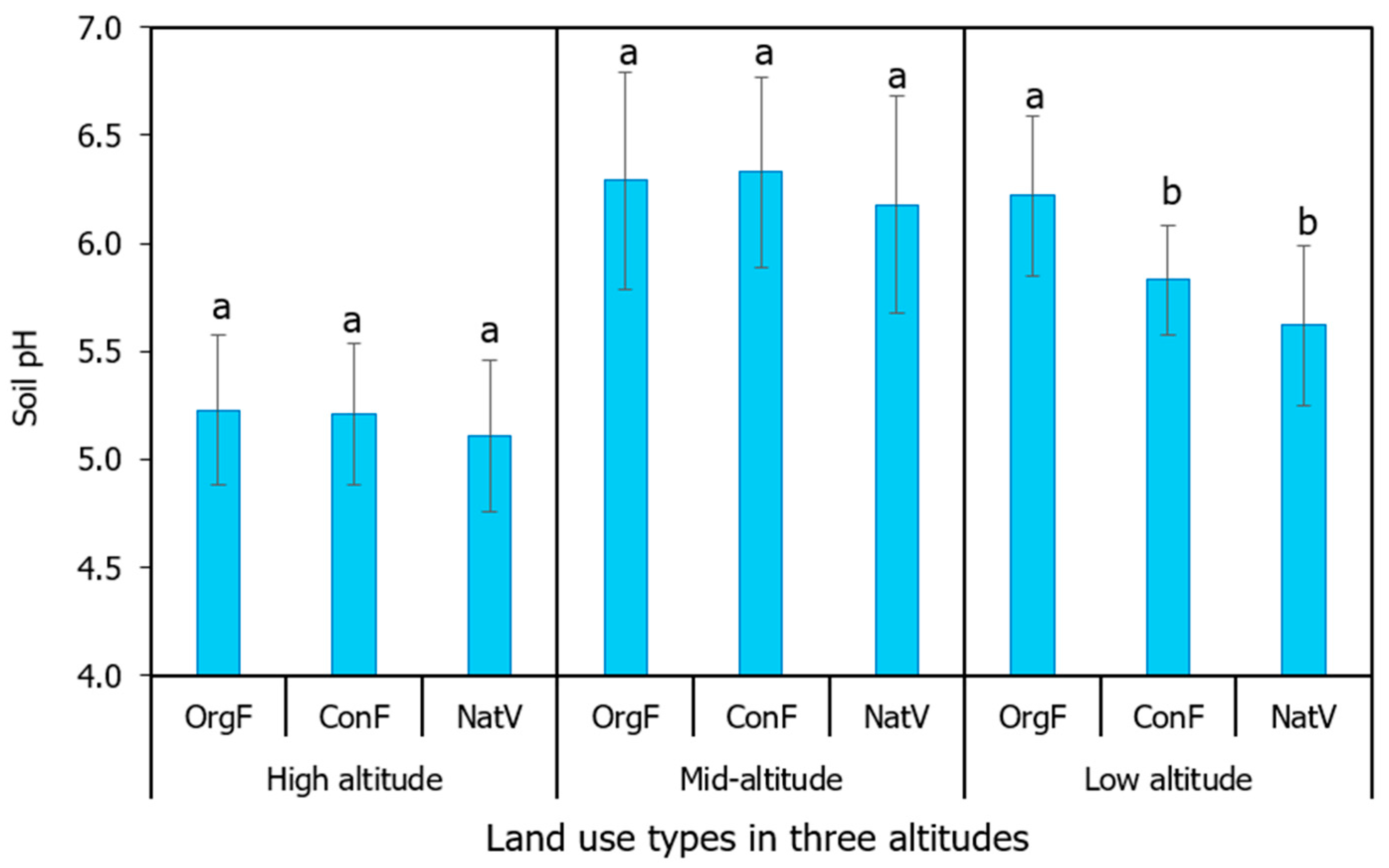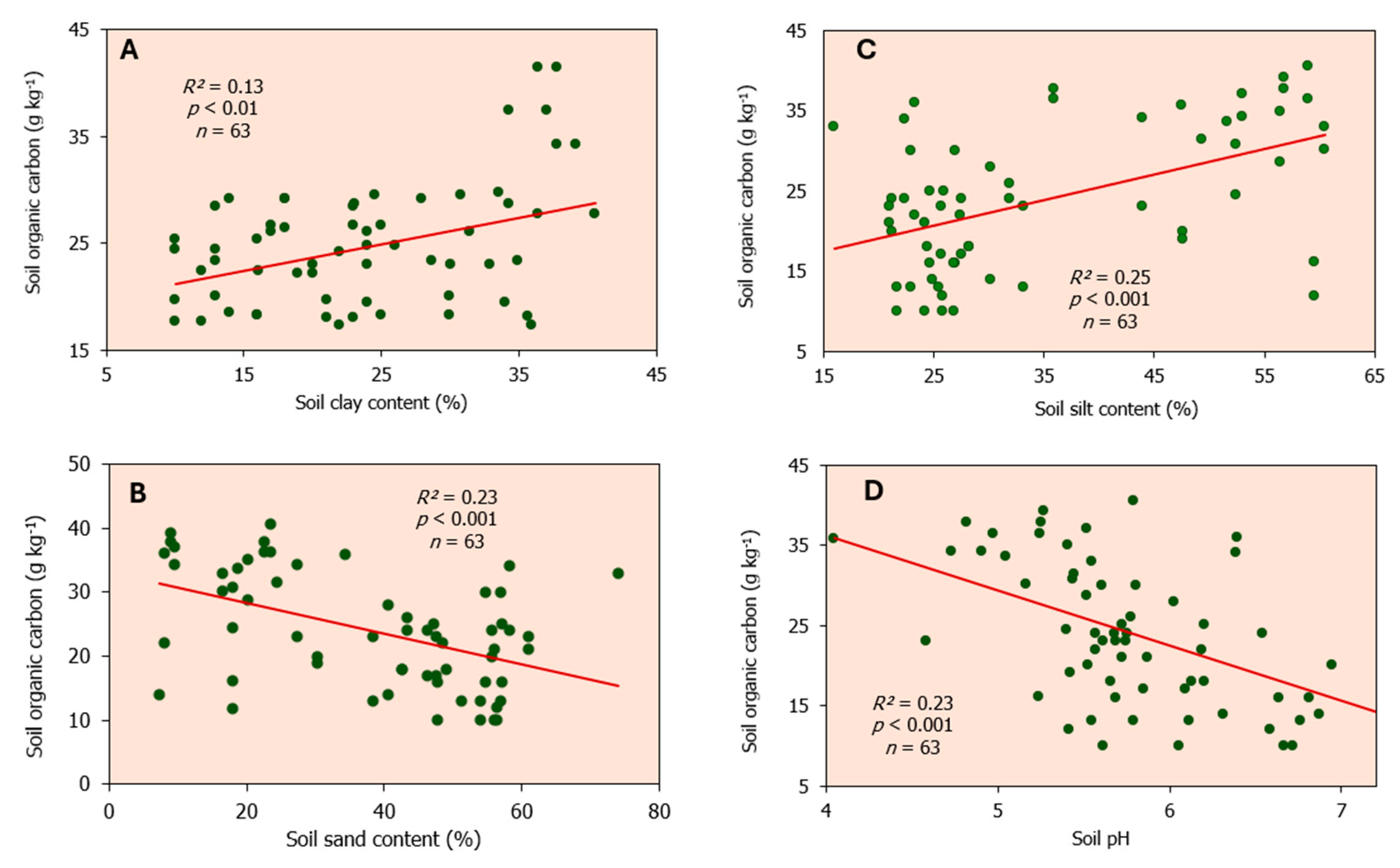Organic and Conventional Management Effects on Soil Organic Carbon and Macro-Nutrients Across Land Uses in the Bhutanese Himalayas
Abstract
1. Introduction
2. Materials and Methods
2.1. Study Area and Research Design
2.2. Land Use History and Vegetation Composition of the Study Sites
2.3. Climatic Conditions
2.4. Soil Sampling and Laboratory Analysis
2.5. Statistical Analysis
3. Results
3.1. Summarized Test Statistics Using ANOVA
3.2. SOC Content Across Three Altitudes
3.3. Soil Total N Content Across Three Altitudes
3.4. Soil Carbon:Nitrogen Ratios
3.5. Soil pH Across Three Altitudes
3.6. Soil Available P Across Three Altitudes
3.7. Soil Available K Across Three Altitudes
3.8. Relationships of Soil C to Texture and pH
4. Discussion
5. Conclusions
Author Contributions
Funding
Institutional Review Board Statement
Informed Consent Statement
Data Availability Statement
Acknowledgments
Conflicts of Interest
References
- FRMD. Land Use and Land Cover Assessment of Bhutan 2016: Technical Report; Forest Resources Management Division, Department of Forests and Park Services, Ministry of Agriculture and Forests, Royal Government of Bhutan: Thimphu, Bhutan, 2016. [Google Scholar]
- Yangka, D.; Vanessa, R.; Newman, P. Carbon neutral policy in action: The case of Bhutan. Clim. Policy 2019, 19, 672–687. [Google Scholar] [CrossRef]
- Yangka, D.; Rauland, V.; Newman, P. Carbon neutral Bhutan: Sustaining carbon neutral status under growth pressures. Sustain. Earth Rev. 2023, 6, 4. [Google Scholar] [CrossRef]
- NSB. National Accounts Statistics; National Statistics Bureau, Royal Government of Bhutan: Thimphu, Bhutan, 2024. Available online: www.nsb.gov.bt (accessed on 23 May 2025).
- Feuerbacher, A.; Luckmann, J.; Boysen, O.; Zikeli, S.; Grethe, H. Is Bhutan destined for 100% organic? Assessing the economy-wide effects of a large-scale conversion policy. PLoS ONE 2018, 13, e0199025. [Google Scholar] [CrossRef] [PubMed]
- Duba, S.; Ghimiray, M.; Gurung, T.R. Promoting Organic Farming in Bhutan: A Review of Policy, Implementation and Constraints; Council for RNR Research of Bhutan: Thimphu, Bhutan, 2008. [Google Scholar]
- Trewavas, A. Urban myths of organic farming. Nature 2001, 410, 409–410. [Google Scholar] [CrossRef] [PubMed]
- Badgley, C.; Moghtader, J.; Quintero, E.; Zakem, E.; Chappell, M.J.; Avilés-Vázquez, K.; Samulon, A.; Perfecto, I. Organic agriculture and the global food supply. Renew. Agric. Food Syst. 2007, 22, 86–108. [Google Scholar] [CrossRef]
- Seufert, V.; Ramankutty, N.; Foley, J.A. Comparing the yields of organic and conventional agriculture. Nature 2012, 485, 229–232. [Google Scholar] [CrossRef]
- Lal, R. Soil carbon sequestration to mitigate climate change. Geoderma 2004, 123, 1–22. [Google Scholar] [CrossRef]
- de Vries, W. Soil carbon 4 per mille: A good initiative but let’s manage not only the soil but also the expectations. Geoderma 2018, 309, 111–112. [Google Scholar] [CrossRef]
- Lal, R. Promoting “4 Per Thousand” and “Adapting African Agriculture” by south-south cooperation: Conservation agriculture and sustainable intensification. Soil Tillage Res. 2019, 188, 27–34. [Google Scholar] [CrossRef]
- Gerke, J. The central role of soil organic matter in soil fertility and carbon storage. Soil Syst. 2022, 6, 33. [Google Scholar] [CrossRef]
- Khangura, R.; Ferris, D.; Wagg, C.; Bowyer, J. Regenerative agriculture—A literature review on the practices and mechanisms used to improve soil health. Sustainability 2023, 15, 2338. [Google Scholar] [CrossRef]
- Bajgai, Y.; Kristiansen, P.; Hulugalle, N.; McHenry, M. Factors and mechanisms regulating soil organic carbon in agricultural systems. In Agroecology, Ecosystems, and Sustainability; Benkeblia, N., Ed.; CRC Press, Taylor & Francis: Boca Raton, FL, USA, 2014; pp. 41–56. [Google Scholar]
- Lehmann, J.; Bossio, D.A.; Kögel-Knabner, I.; Rillig, M.C. The concept and future prospects of soil health. Nat. Rev. Earth Environ. 2020, 1, 544–553. [Google Scholar] [CrossRef]
- Bajgai, Y.; Kristiansen, P.; Hulugalle, N.; McHenry, M.; McCorkell, B. Soil organic carbon and microbial biomass carbon under organic and conventional vegetable cropping systems in an Alfisol and a Vertisol. Nutr. Cycl. Agroecosyst. 2015, 101, 1–15. [Google Scholar] [CrossRef]
- Seufert, V.; Ramankutty, N. Many shades of gray—The context-dependent performance of organic agriculture. Sci. Adv. 2017, 3, e1602638. [Google Scholar] [CrossRef]
- Blockeel, J.; Schader, C.; Heidenreich, A.; Grovermann, C.; Kadzere, I.; Egyir, I.S.; Muriuki, A.; Bandanaa, J.; Tanga, C.M.; Clottey, J.; et al. Do organic farming initiatives in Sub-Saharan Africa improve the sustainability of smallholder farmers? Evidence from five case studies in Ghana and Kenya. J. Rural Stud. 2023, 98, 34–58. [Google Scholar] [CrossRef]
- Neuhoff, D.; Tashi, S.; Rahmann, G.; Denich, M. Organic agriculture in Bhutan: Potential and challenges. Org. Agric. 2014, 4, 209–221. [Google Scholar] [CrossRef]
- Tshomo, K.; Dorji, Y. National Framework for Organic Farming in Bhutan; Department of Agriculture, Ministry of Agriculture, Royal Government of Bhutan: Thimphu, Bhutan, 2006. [Google Scholar]
- Tashi, S.; Wangchuk, K. Prospects of organic farming in Bhutan: A SWOT analysis. Adv. Agric. 2016, 2016, 1717352. [Google Scholar] [CrossRef]
- Adhikari, A.; Bajgai, Y.; Rabgyal, J.; Lal, R.; Tshering, N.; Gurung, S.; Wangdi, T. Altitude, land use and soil depth effects on earthworm density and its relationship to soil properties in an on-farm study. J. Soil Sci. Plant Nutr. 2024, 24, 6569–6583. [Google Scholar] [CrossRef]
- Tshotsho; Lippert, C.; Zikeli, S.; Krimly, T.; Barissoul, A.; Feuerbacher, A. The role of management and farming practices, yield gaps, nutrient balance, and institutional settings in the context of large-scale organic conversion in Bhutan. Agric. Syst. 2024, 220, 104057. [Google Scholar] [CrossRef]
- Dorji, K.D.; Dema, Y.; Uden, T. Effect of different rates and combinations of farm yard manure and inorganic fertilizers on chili (Capsicum annum) yield. Bhu. J. RNR 2009, 5, 1–14. [Google Scholar]
- Rai, P.; Tulsi, G.; Sonam, T. Comparative economic analysis of potato production in Western Bhutan-conventional versus in-conversion to organic. Cogent Food Agric. 2025, 11, 2493127. [Google Scholar] [CrossRef]
- Lepcha, N.; Mankeb, P.; Suwanmaneepong, S. Productivity and profitability of organic and conventional potato (Solanum tuberosum L.) production in West-Central Bhutan. Open Agric. 2021, 6, 640–654. [Google Scholar] [CrossRef]
- David, W.; Auerbach, R.; Bügel, S.G.; Chander, M.; Saeed, M.F.; Hernandez, L.F.; Melati, M.; Tashi, S.; Sinicom, S. Organic Food System: An overview and its challenges for healthy food systems. Org. Agric. 2025, 15, 147–158. [Google Scholar] [CrossRef]
- Tshotsho; Lippert, C.; Feuerbacher, A. Organic agriculture, labour exchange, and social networks: A case study of smallholder farming in Bhutan. Org. Agric. 2023, 13, 83–98. [Google Scholar] [CrossRef]
- Lacoste, M.; Cook, S.; McNee, M.; Gale, D.; Ingram, J.; Bellon-Maurel, V.; MacMillan, T.; Sylvester-Bradley, R.; Kindred, D.; Bramley, R.; et al. On-Farm Experimentation to transform global agriculture. Nat. Food 2022, 3, 11–18. [Google Scholar] [CrossRef] [PubMed]
- Toffolini, Q.; Jeuffroy, M. On-farm experimentation practices and associated farmer-researcher relationships: A systematic literature review. Agron. Sustain. Dev. 2022, 42, 114. [Google Scholar] [CrossRef]
- Wood, S.A.; Bowman, M. Large-scale farmer-led experiment demonstrates positive impact of cover crops on multiple soil health indicators. Nat. Food 2021, 2, 97–103. [Google Scholar] [CrossRef] [PubMed]
- Crookston, B.; Yost, M.; Bowman, M.; Veum, K. Relationships of on-farm soil health scores with corn and soybean yield in the midwestern United States. Soil Sci. Soc. Am. J. 2022, 86, 91–105. [Google Scholar] [CrossRef]
- Gahukar, R.T. Cow urine: A potential biopesticide. Indian J. Entomol. 2013, 75, 212–216. [Google Scholar]
- Loo, Y.Y.; Billa, L.; Singh, A. Effect of climate change on seasonal monsoon in Asia and its impact on the variability of monsoon rainfall in Southeast Asia. Geosci. Front. 2015, 6, 817–823. [Google Scholar] [CrossRef]
- IUSS Working Group WRB. World Reference Base for Soil Resources 2014, Update 2015 International Soil Classification System for Naming Soils and Creating Legends for Soil Maps; World Soil Resources Reports No. 106; FAO: Rome, Italy, 2015. [Google Scholar]
- NSSC. Tecnical Report on the Generation of National Soil Map of Bhutan Using Digital Soil Mapping Techniques; Report No. SS 28; National Soil Services Centre (NSSC), Department of Agriculture, Ministry of Agriculture and Livestock: Thimphu, Bhutan, 2023. [Google Scholar]
- Nelson, D.W.; Sommers, L.E. Total carbon, organic carbon and organic matter. In Methods of Soil Analysis: Part 2. Chemical and Microbiological Properties—Agronomy Monograph No. 9; Page, A.L., Ed.; ASA: Madison, WI, USA, 1982; pp. 539–579. [Google Scholar]
- Dewis, J.; Freitas, F. Physical and Chemical Methods of Soil and Water Analysis; FAO soils Bulletin; FAO: Rome, Italy, 1970. [Google Scholar]
- Steele, L.D.; Ramsey, K.J.; Kane, P.F. Elimination of aliquoting in automated flame photometric determination of K2O in fertilizers. J. Assoc. Off. Anal. Chem. 1984, 67, 847–850. [Google Scholar] [CrossRef]
- Gee, G.W.; Or, D. Particle-Size Analysis. In Methods of Soil Analysis: Part 4 Physical Methods; SSSA Book Series No. 5; Dane, J.H., Topp, G.C., Eds.; SSSA: Madison, WI, USA, 2002. [Google Scholar]
- IRRI. Statistical Tool for Agricultural Research (STAR) v. 2.0.1; IRRI: Los Banos, Philippines, 2014. [Google Scholar]
- Conant, R.T.; Ryan, M.G.; Ågren, G.I.; Birge, H.E.; Davidson, E.A.; Eliasson, P.E.; Evans, S.E.; Frey, S.D.; Giardina, C.P.; Hopkins, F.M.; et al. Temperature and soil organic matter decomposition rates–synthesis of current knowledge and a way forward. Glob. Change Biol. 2011, 17, 3392–3404. [Google Scholar] [CrossRef]
- Davidson, E.A.; Janssens, I.A. Temperature sensitivity of soil carbon decomposition and feedbacks to climate change. Nature 2006, 440, 165–173. [Google Scholar] [CrossRef]
- Choudhury, B.U.; Fiyaz, A.R.; Mohapatra, K.P.; Ngachan, S. Impact of Land Uses, Agrophysical Variables and Altitudinal Gradient on Soil Organic Carbon Concentration of North-Eastern Himalayan Region of India. Land Degrad. Dev. 2016, 27, 1163–1174. [Google Scholar] [CrossRef]
- Ruiz Sinoga, J.D.; Pariente, S.; Diaz, A.R.; Martinez Murillo, J.F. Variability of relationships between soil organic carbon and some soil properties in Mediterranean rangelands under different climatic conditions (South of Spain). Catena 2012, 94, 17–25. [Google Scholar] [CrossRef]
- Bai, Z.; Caspari, T.; Gonzalez, M.R.; Batjes, N.H.; Mäder, P.; Bünemann, E.K.; de Goede, R.; Brussaard, L.; Xu, M.; Ferreira, C.S.S.; et al. Effects of agricultural management practices on soil quality: A review of long-term experiments for Europe and China. Agric. Ecosyst. Environ. 2018, 265, 1–7. [Google Scholar] [CrossRef]
- Sun, X.-L.; Minasny, B.; Wu, Y.-J.; Wang, H.-L.; Fan, X.-H.; Zhang, G.-L. Soil organic carbon content increase in the east and south of China is accompanied by soil acidification. Sci. Total Environ. 2023, 857, 159253. [Google Scholar] [CrossRef]
- Liao, K.; Wu, S.; Zhu, Q. Can soil pH be used to help explain soil organic carbon stocks? Clean Soil Air Water 2016, 44, 1685–1689. [Google Scholar] [CrossRef]
- Wang, C.; Kuzyakov, Y. Soil organic matter priming: The pH effects. Glob. Change Biol. 2024, 30, e17349. [Google Scholar] [CrossRef] [PubMed]
- Ritchie, G.S.P.; Dolling, P.J. The role of organic matter in soil acidification. Soil Res. 1985, 23, 569–576. [Google Scholar] [CrossRef]
- Thabit, F.N.; El-Shater, A.-H.; Soliman, W. Role of silt and clay fractions in organic carbon and nitrogen stabilization in soils of some old fruit orchards in the Nile floodplain, Sohag Governorate, Egypt. J. Soil Sci. Plant Nutr. 2023, 23, 2525–2544. [Google Scholar] [CrossRef]
- Baldock, J.A.; Skjemstad, J.O. Role of the soil matrix and minerals in protecting natural organic materials against biological attack. Org. Geochem. 2000, 31, 697–710. [Google Scholar] [CrossRef]
- Dhaliwal, S.S.; Naresh, R.K.; Gupta, R.K.; Panwar, A.S.; Mahajan, N.C.; Singh, R.; Mandal, A. Effect of tillage and straw return on carbon footprints, soil organic carbon fractions and soil microbial community in different textured soils under rice–wheat rotation: A review. Rev. Environ. Sci. Bio/Technol. 2020, 19, 103–115. [Google Scholar] [CrossRef]
- Kleber, M.; Mikutta, R.; Torn, M.S.; Jahn, R. Poorly crystalline mineral phases protect organic matter in acid subsoil horizons. Eur. J. Soil Sci. 2005, 56, 717–725. [Google Scholar] [CrossRef]
- Huang, J.; Hartemink, A.E. Soil and environmental issues in sandy soils. Earth-Sci. Rev. 2020, 208, 103295. [Google Scholar] [CrossRef]
- Lützow, M.V.; Kögel-Knabner, I.; Ekschmitt, K.; Matzner, E.; Guggenberger, G.; Marschner, B.; Flessa, H. Stabilization of organic matter in temperate soils: Mechanisms and their relevance under different soil conditions—A review. Eur. J. Soil Sci. 2006, 57, 426–445. [Google Scholar] [CrossRef]
- Ernfors, M.; von Arnold, K.; Stendahl, J.; Olsson, M.; Klemedtsson, L. Nitrous oxide emissions from drained organic forest soils––an up-scaling based on C:N ratios. Biogeochemistry 2007, 84, 219–231. [Google Scholar] [CrossRef]
- Springob, G.; Kirchmann, H. Bulk soil C to N ratio as a simple measure of net N mineralization from stabilized soil organic matter in sandy arable soils. Soil Biol. Biochem. 2003, 35, 629–632. [Google Scholar] [CrossRef]
- Cui, J.; Zhu, R.; Wang, X.; Xu, X.; Ai, C.; He, P.; Liang, G.; Zhou, W.; Zhu, P. Effect of high soil C/N ratio and nitrogen limitation caused by the long-term combined organic-inorganic fertilization on the soil microbial community structure and its dominated SOC decomposition. J. Environ. Manag. 2022, 303, 114155. [Google Scholar] [CrossRef] [PubMed]
- van der Sloot, M.; Kleijn, D.; De Deyn, G.B.; Limpens, J. Carbon to nitrogen ratio and quantity of organic amendment interactively affect crop growth and soil mineral N retention. Crop Environ. 2022, 1, 161–167. [Google Scholar] [CrossRef]
- Bajgai, Y.; Sangchyoswat, C. Farmers knowledge of soil fertility in West-Central Bhutan. Geoderma Reg. 2018, 14, e00188. [Google Scholar] [CrossRef]
- Bajgai, Y.; Yeshey, Y.; De Mastro, G.; Ghimiray, M.; Chhogyel, N.; Tshewang, S.; Alhajj Ali, S. Influence of nitrogen application on wheat crop performance, soil properties, greenhouse gas emissions and carbon footprint in central Bhutan. Environ. Dev. 2019, 32, 100469. [Google Scholar] [CrossRef]
- Nemecek, T.; Dubois, D.; Huguenin-Elie, O.; Gaillard, G. Life cycle assessment of Swiss farming systems: I. Integrated and organic farming. Agric. Syst. 2011, 104, 217–232. [Google Scholar] [CrossRef]
- Penn, C.J.; Camberato, J.J. A Critical Review on Soil Chemical Processes that Control How Soil pH Affects Phosphorus Availability to Plants. Agriculture 2019, 9, 120. [Google Scholar] [CrossRef]
- Menezes-Blackburn, D.; Giles, C.; Darch, T.; George, T.S.; Blackwell, M.; Stutter, M.; Shand, C.; Lumsdon, D.; Cooper, P.; Wendler, R.; et al. Opportunities for mobilizing recalcitrant phosphorus from agricultural soils: A review. Plant Soil 2018, 427, 5–16. [Google Scholar] [CrossRef]
- Wilfert, P.; Kumar, P.S.; Korving, L.; Witkamp, G.-J.; van Loosdrecht, M.C.M. The Relevance of Phosphorus and Iron Chemistry to the Recovery of Phosphorus from Wastewater: A Review. Environ. Sci. Technol. 2015, 49, 9400–9414. [Google Scholar] [CrossRef] [PubMed]
- Fu, W.; Tunney, H.; Zhang, C. Spatial variation of soil nutrients in a dairy farm and its implications for site-specific fertilizer application. Soil Tillage Res. 2010, 106, 185–193. [Google Scholar] [CrossRef]
- Tittonell, P.; Muriuki, A.; Klapwijk, C.J.; Shepherd, K.D.; Coe, R.; Vanlauwe, B. Soil heterogeneity and soil fertility gradients in smallholder farms of the East African highlands. Soil Sci. Soc. Am. J. 2013, 77, 525–538. [Google Scholar] [CrossRef]







| Geog/ Altitude | Land Use | Crop Types/Vegetation | Manure/Fertilizer | Pesticides/ Biopesticides | Land Preparation: |
|---|---|---|---|---|---|
| Sephu, High-altitude | OrgF | Radish (Raphanus sativus), turnip (Brassica rapa) and onion (Allium cepa) and land fallowed for 3–6 months over winter | Farmyard manure (FYM) and leaflitter; 12–25 Mg ha−1; yaks grazed in the field during off-season or when the land was left fallow & practiced 6–15 years | Cattle urine | Mini power-tiller |
| NatV | Rhododendrons (Rhododendron spp.), great mullein (Verbascum thapsus), ferns (Nephrolepis cordifolia), common mugwort (Artemisia vulgaris), wild strawberry (Fragaria vesca), alpine ducks, shrubs, and grass species | - | - | - | |
| ConF | Potato (Solanum tuberosum) rotated with vegetables (cabbage (Brassica oleracea), turnip, radish) and land fallowed for 3–6 months (winter) | FYM 5–10 Mg ha−1; yaks grazed in the field during off-season or when the land was left fallow: Estimated average: N:P:K 32:20:12 kg ha−1 & practiced 12–20 years. | Herbicide (metribuzin) and pesticides (mancozeb fungicide) | Tractor and mini power tiller | |
| Chapcha, Mid-altitude (2300–2700 masl) | OrgF | Potato rotated with mixture of garlic (Allium sativum), coriander (Coriandrum sativum), leafy vegetables & chili (Capsicum annuum). Some sites under potato-fallow rotation (winter) | FYM and leaflitter; 8–10 Mg ha−1 & practiced 7–12 years | Cattle urine | Mini power tiller |
| NatV | Common mugwort, ferns, grass species, stinging nettle (Urtica dioica), clover (Trifolium repens) & spearmint (Mentha spicata) | - | - | - | |
| ConF | Potato-chili (or peas or maize (Zea mays)) is a common rotation. Some sites potato-fallow rotation (winter) | FYM and leaflitter; 4–5 Mg ha−1; estimated average: N:P:K 32:20:12 kg ha−1 & practiced 15–25 years. | Herbicide (metribuzin) and pesticides (mancozeb fungicide) | Mini power tiller | |
| Tsendagang, Low-altitude | OrgF | Potato or maize rotated with ground apple (Smallanthus sonchifolius) or vegetables (beans (Phaseolus vulgaris L.), chili), Citrus spp., cabbage, peas (Pisum sativum), cucumber (Cucumus sativus L.) and tomato); land cultivated over winter | FYM: 1–2 Mg ha−1 & practiced 4–8 years. | Cattle urine | Plowing using oxen or power-tiller |
| NatV | Fern, common mugwort, grass species, Cottonweed (Ageratina Adenophora), Prickly Ash (Zanthoxylum armatum), and bamboo (Bambusa vulgaris). | - | - | - | |
| ConF | Mainly potato-maize (beans and soybeans (Glycine max L. Merr.) also cultivated in small quantities); Part of the lands is cultivated over winter and the rest is fallowed. | FYM; 0.5–1 Mg ha−1; estimated average: N:P:K 40:32:12 kg ha−1 & practiced 4–7 years. | Herbicicides (Metribuzin) and fungicides and some insecticides. | Plowing using oxen or power-tiller |
| Altitude Category (geog) | Soil Attributes | n | df | Mean Square | F-Value | p-Value |
|---|---|---|---|---|---|---|
| High-altitude (Sephu) | SOC (g kg−1) | 21 | 2 | 290.80 | 10.07 | 0.001 |
| Total N (g kg−1) | 21 | 2 | 0.97 | 2.85 | 0.084 | |
| C:N ratio | 21 | 2 | 9.22 | 2.45 | 0.114 | |
| Soil pH | 21 | 2 | 0.03 | 0.16 | 0.851 | |
| Available P (mg kg−1) | 21 | 2 | 2541.18 | 5.42 | 0.014 | |
| Available K (mg kg−1) § | 21 | 2 | 0.08 | 0.46 | 0.638 | |
| Mid-altitude (Chapcha) | SOC (g kg−1) | 21 | 2 | 133.00 | 2.49 | 0.111 |
| Total N (g kg−1) | 21 | 2 | 1.92 | 2.91 | 0.080 | |
| C:N ratio | 21 | 2 | 56.12 | 2.45 | 0.114 | |
| Soil pH | 21 | 2 | 0.04 | 0.15 | 0.864 | |
| Available P (mg kg−1) | 21 | 2 | 7978.43 | 6.67 | 0.007 | |
| Available K (mg kg−1) | 21 | 2 | 26,170.68 | 1.42 | 0.267 | |
| Low-altitude (Tshendagang) | SOC (g kg−1) | 21 | 2 | 36.05 | 1.42 | 0.268 |
| Total N (g kg−1) | 21 | 2 | 0.02 | 0.15 | 0.864 | |
| C:N ratio | 21 | 2 | 84.50 | 1.05 | 0.371 | |
| Soil pH | 21 | 2 | 0.63 | 8.79 | 0.002 | |
| Available P (mg kg−1) § | 21 | 2 | 13.65 | 1.10 | 0.356 | |
| Available K (mg kg−1) § | 21 | 2 | 0.56 | 10.69 | 0.001 |
| Altitude Category | Land Use | Min | Max | Mean | Standard Deviation | Median |
|---|---|---|---|---|---|---|
| High-altitude | OrgF | 2.20 | 3.60 | 2.91 a | 0.53 | 2.90 |
| ConF | 1.10 | 2.90 | 2.17 a | 0.72 | 2.30 | |
| NatV | 1.90 | 3.20 | 2.54 a | 0.46 | 2.70 | |
| Mid-altitude | OrgF | 1.00 | 2.60 | 1.70 a | 0.52 | 1.60 |
| ConF | 0.40 | 1.40 | 0.91 a | 0.33 | 0.80 | |
| NatV | 0.50 | 3.90 | 1.89 a | 1.26 | 1.40 | |
| Low-altitude | OrgF | 0.30 | 1.70 | 0.87 a | 0.54 | 0.80 |
| ConF | 0.40 | 1.30 | 0.91 a | 0.35 | 1.00 | |
| NatV | 0.50 | 1.20 | 0.80 a | 0.26 | 0.80 |
| Altitude Category | Land Use | Min | Max | Mean | Standard Deviation | Median |
|---|---|---|---|---|---|---|
| High-altitude | OrgF | 10.10 | 17.00 | 13.09 a | 2.64 | 12.80 |
| ConF | 10.60 | 12.70 | 11.36 a | 0.85 | 11.00 | |
| NatV | 10.90 | 16.40 | 13.53 a | 1.89 | 13.50 | |
| Mid-altitude | OrgF | 10.00 | 16.00 | 13.69 a | 2.16 | 14.00 |
| ConF | 14.30 | 25.00 | 19.29 a | 3.94 | 19.10 | |
| NatV | 8.70 | 26.30 | 17.21 a | 6.96 | 16.40 | |
| Low-altitude | OrgF | 7.60 | 33.30 | 24.83 a | 10.70 | 30.00 |
| ConF | 13.80 | 40.00 | 20.77 a | 8.80 | 18.00 | |
| NatV | 20.00 | 40.00 | 27.69 a | 7.09 | 26.00 |
| Altitude Category | Land Use | Min | Max | Mean | Standard Deviation | Median |
|---|---|---|---|---|---|---|
| High-altitude | OrgF | 12.98 | 334.88 | 120.93 a | 115.60 | 57.32 |
| ConF | 12.98 | 334.88 | 120.93 a | 115.60 | 57.32 | |
| NatV | 73.53 | 268.76 | 133.88 a | 78.41 | 81.44 | |
| Mid-altitude | OrgF | 72.61 | 595.11 | 258.08 a | 190.19 | 198.88 |
| ConF | 60.00 | 4.38.49 | 190.97 a | 103.74 | 164.42 | |
| NatV | 52.40 | 234.77 | 135.99 a | 67.09 | 143.37 | |
| Low-altitude | OrgF | 85.99 | 210.73 | 145.64 a | 39.19 | 135.52 |
| ConF | 71.32 | 362.14 | 137.31 a | 120.85 | 97.62 | |
| NatV | 18.97 | 101.50 | 50.06 b | 32.56 | 35.26 |
Disclaimer/Publisher’s Note: The statements, opinions and data contained in all publications are solely those of the individual author(s) and contributor(s) and not of MDPI and/or the editor(s). MDPI and/or the editor(s) disclaim responsibility for any injury to people or property resulting from any ideas, methods, instructions or products referred to in the content. |
© 2025 by the authors. Licensee MDPI, Basel, Switzerland. This article is an open access article distributed under the terms and conditions of the Creative Commons Attribution (CC BY) license (https://creativecommons.org/licenses/by/4.0/).
Share and Cite
Bajgai, Y.; Adhikari, A.; Lal, R.; Wangdi, T. Organic and Conventional Management Effects on Soil Organic Carbon and Macro-Nutrients Across Land Uses in the Bhutanese Himalayas. Soil Syst. 2025, 9, 99. https://doi.org/10.3390/soilsystems9030099
Bajgai Y, Adhikari A, Lal R, Wangdi T. Organic and Conventional Management Effects on Soil Organic Carbon and Macro-Nutrients Across Land Uses in the Bhutanese Himalayas. Soil Systems. 2025; 9(3):99. https://doi.org/10.3390/soilsystems9030099
Chicago/Turabian StyleBajgai, Yadunath, Ameeta Adhikari, Rattan Lal, and Tashi Wangdi. 2025. "Organic and Conventional Management Effects on Soil Organic Carbon and Macro-Nutrients Across Land Uses in the Bhutanese Himalayas" Soil Systems 9, no. 3: 99. https://doi.org/10.3390/soilsystems9030099
APA StyleBajgai, Y., Adhikari, A., Lal, R., & Wangdi, T. (2025). Organic and Conventional Management Effects on Soil Organic Carbon and Macro-Nutrients Across Land Uses in the Bhutanese Himalayas. Soil Systems, 9(3), 99. https://doi.org/10.3390/soilsystems9030099








